A Bulletin special report by Dawn Stover
In 1982, a 40-year-old insurance salesman who sold policies to professional athletes traveled from his home in Lawrence, Kansas, to New York City on a business trip. Shortly before he left, Bob Swan, Jr.—the father of two young daughters, and a man increasingly concerned about the possibility of a nuclear war between the United States and the Soviet Union—mentioned to his then-wife Jane that he had had a dream about a film that portrayed an American family and a Russian family in the aftermath of nuclear war and “showed the total absurdity” of such a war. While he was in New York, Swan attended a huge march for nuclear disarmament that was life-changing for him. “When I got back from this amazing experience,” Swan told me when I visited him at his home a few months ago, one of the first things his wife said was: “They announced while you were gone, they’re going to make that film you dreamed about. They’re going to film it in Lawrence.”
The television movie The Day After depicted a full-scale nuclear war and its impacts on people living in and around Kansas City. It became something of a community project in picturesque Lawrence, 40 miles west of Kansas City, where much of the movie was filmed. Thousands of local residents—including students and faculty from the University of Kansas—were recruited as extras for the movie; about 65 of the 80 speaking parts were cast locally. The use of locals was intentional, because the moviemakers wanted to show the grim consequences of a nuclear war for real middle Americans, living in the real middle of the country. By the time the movie ends, almost all of the main characters are dead or dying.
ABC broadcast The Day After on November 20, 1983, with no commercial breaks during the final hour. More than 100 million people saw it—nearly two-thirds of the total viewing audience. It remains one of the most-watched television programs of all time. Brandon Stoddard, then-president of ABC’s motion picture division, called it “the most important movie we’ve ever done.” The Washington Post later described it as “a profound TV moment.” It was arguably the most effective public service announcement in history.
“For those of us who live in Lawrence, it was personal... and it didn’t have a happy ending.”
It was also a turning point for foreign policy. Thirty-five years ago, the United States and the Soviet Union were in a nuclear arms race that had taken them to the brink of war. The Day After was a piercing wakeup shriek, not just for the general public but also for then-President Ronald Reagan. Shortly after he saw the film, Reagan gave a speech saying that he, too, had a dream: that nuclear weapons would be “banished from the face of the Earth.” A few years later, Reagan and Soviet leader Mikhail Gorbachev signed the Intermediate-Range Nuclear Forces (INF) Treaty, the first agreement that provided for the elimination of an entire category of nuclear weapons. By the late 1990s, American and Russian leaders had created a stable, treaty-based arms-control infrastructure and expected it to continue improving over time.
Now, however, a long era of nuclear restraint appears to be nearing an end. Tensions between the United States and Russia have risen to levels not seen in decades. Alleging treaty violations by Russia, the White House has announced plans to withdraw from the INF Treaty. Both countries are moving forward with the enormously expensive refurbishment of old and development of new nuclear weapons—a process euphemized as “nuclear modernization.” Leaders on both sides have made inflammatory statements, and no serious negotiations have taken place in recent years.
There are striking parallels between the security situations today and 35 years ago, with one major discordance: Today, nuclear weapons are seldom a front-burner concern, largely being forgotten, underestimated, or ignored by the American public. The United States desperately needs a fresh national conversation about the born-again nuclear arms race—a conversation loud enough to catch the attention of the White House and the Kremlin and lead to resumed dialogue. A look back at The Day After and the role played by ordinary citizens in a small Midwestern city shows how the risk of nuclear war took center stage in 1983, and what it would take for that to happen again in 2018.
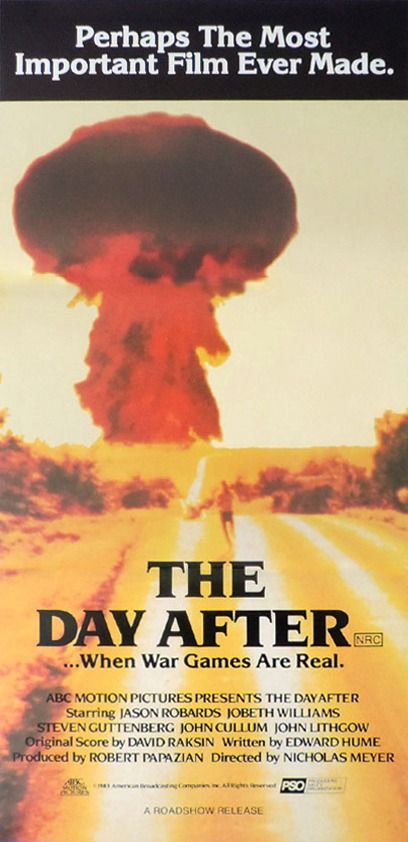
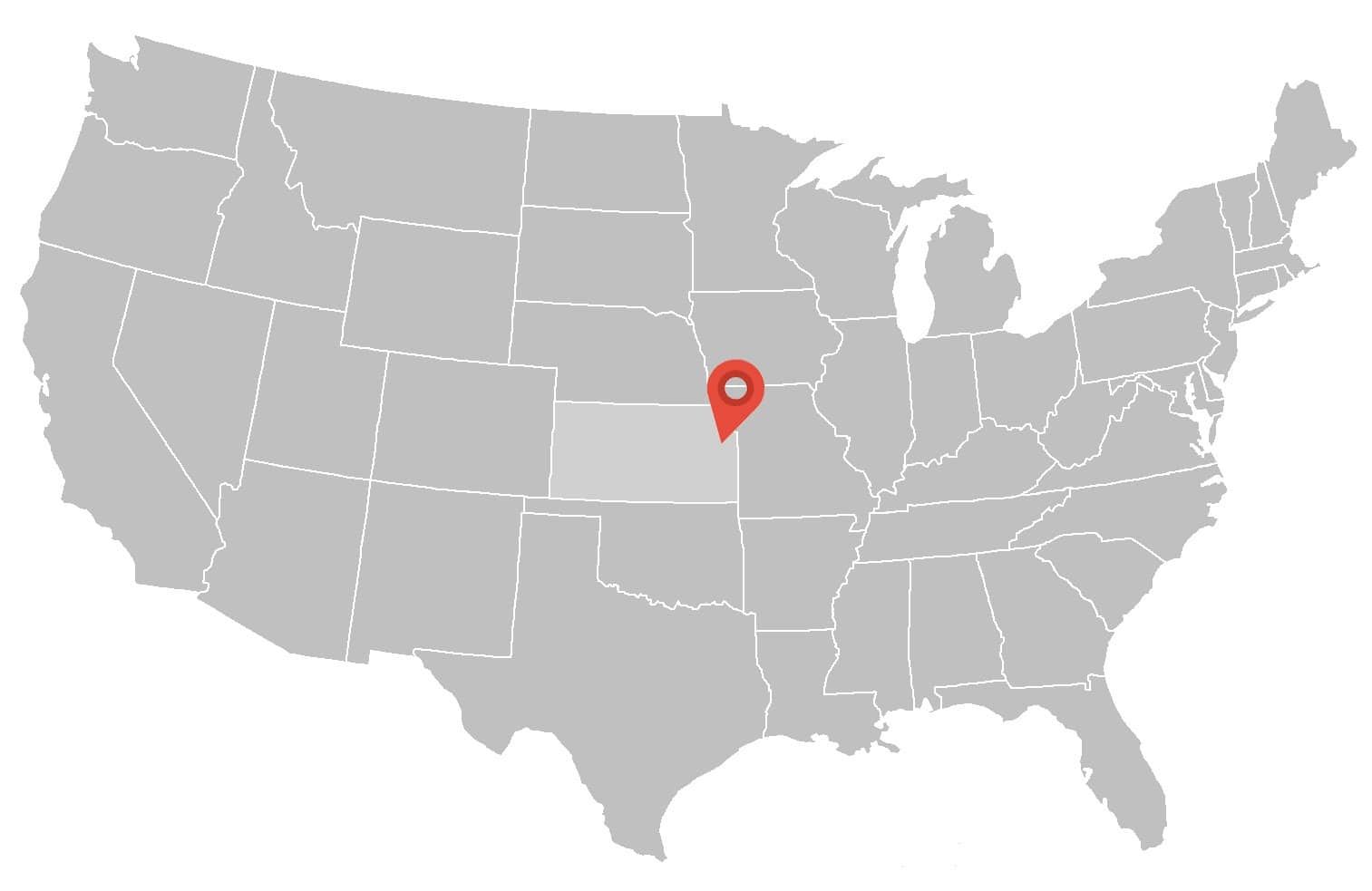
Lawrence is southeast of the geographic center of the contiguous United States. It's also just across the Kansas border from Whiteman Air Force Base in Missouri, where 150 Minuteman II missiles were deployed.
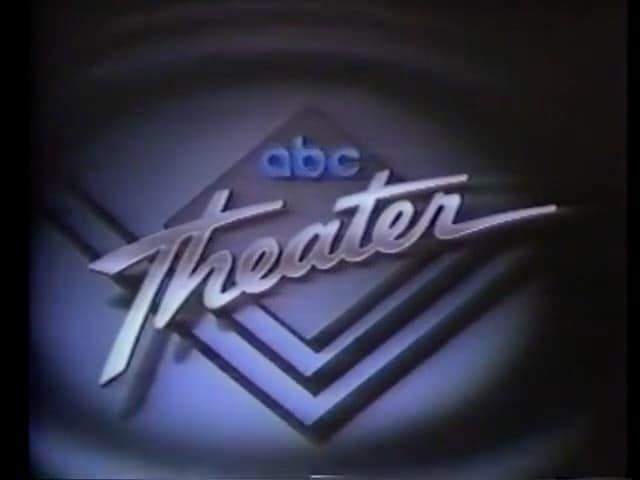
A CITY IN ASHES
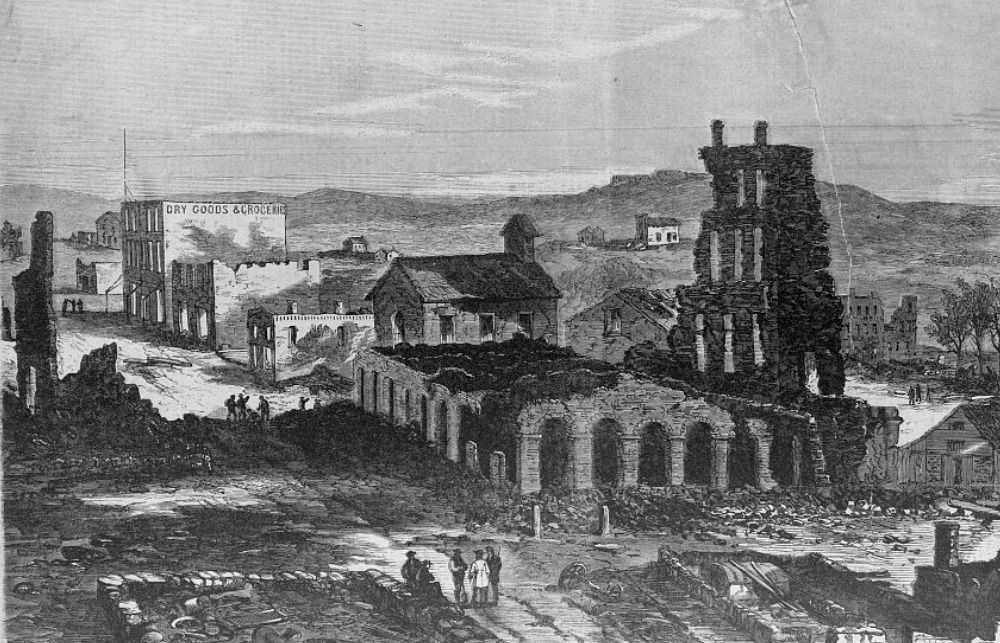
Above: A Harper's Weekly illustration of the 1863 destruction of Lawrence by William Quantrill and Confederate guerillas, with ruins of the Eldridge Hotel in the foreground. Library of Congress / Wikimedia Commons
Below: Aftermath of the nuclear attack on Lawrence depicted in The Day After.
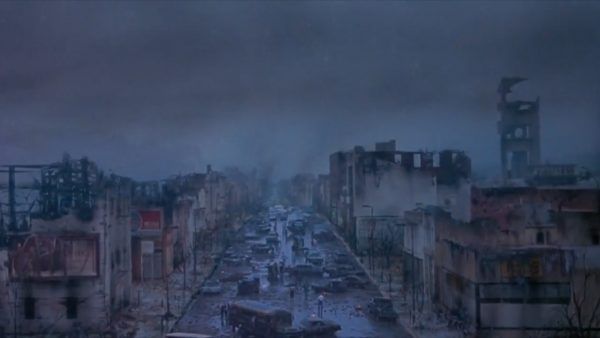
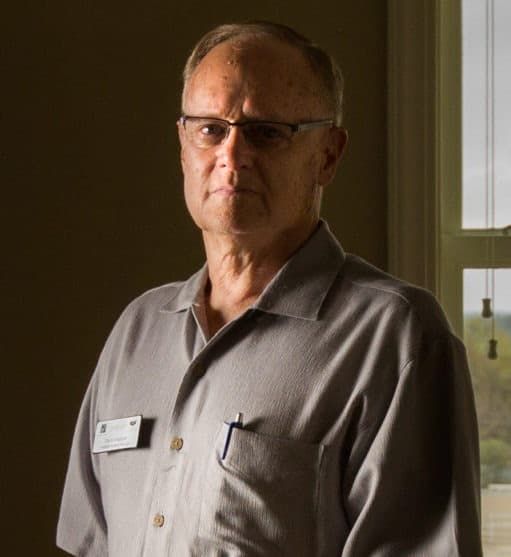
Above: David Longhurst photographed in 2016 at the Eldridge Hotel, where he is assistant general manager and part-owner. Longhurst was mayor of Lawrence at the time of The Day After broadcast in 1983. Courtesy: Lawrence (Kan.) Journal-World
Below: The "refugee" tent city created for The Day After along the banks of the Kansas River. Courtesy: Lawrence (Kan.) Journal-World
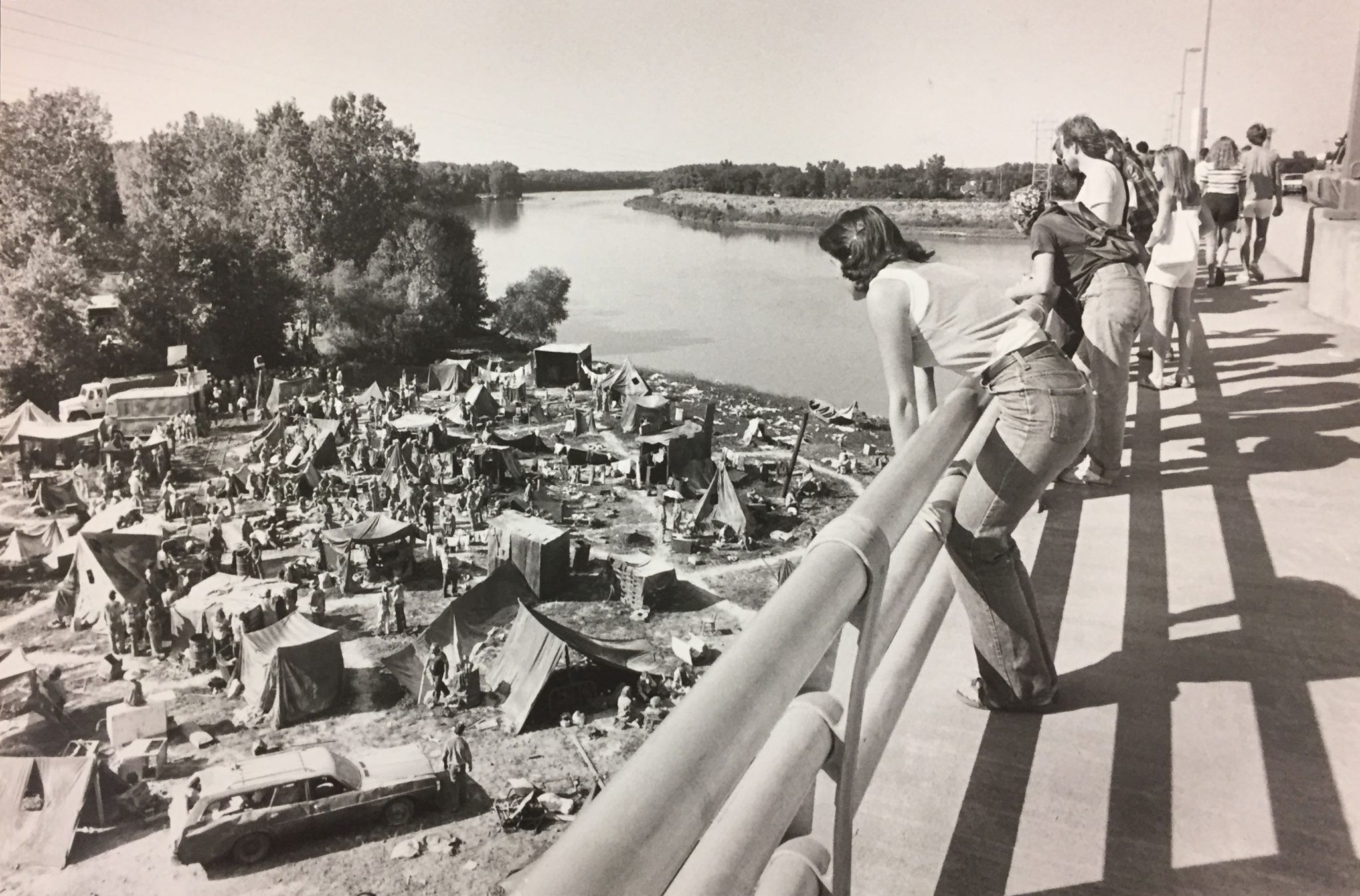
In the film, a 12-year-old farm girl named “Joleen” who has heard an alarming report on the radio asks her father, “There’s not going be a war, is there?” That question was “really emotional for me,” says David Longhurst, who was mayor of Lawrence in 1983 and is now in his mid-70s. He had a son who was 12 at the time, and the girl who played “Joleen” was the daughter of close friends. The Day After had a huge impact on the American psyche. But, Longhurst says, “for those of us who live in Lawrence, it had an even greater impact. It was personal ... and it didn’t have a happy ending.”
In fact, Lawrence—a small city of less than 100,000, including about 30,000 students at the University of Kansas, that lies between two rivers and is dotted with leafy parks and limestone buildings—has a long history of devastation, followed by repeated resurrection. It was founded by anti-slavery settlers who hoped that Kansas would enter the union as a free state. In 1856, pro-slavery activists led by the county sheriff sacked the town. They burned down the Free State Hotel, but a prominent abolitionist named Col. Shalor Eldridge rebuilt the hotel and named it after himself. The hotel, in the midst of another renovation, is where I met Longhurst a few months ago. A part-owner of the hotel, he showed me its Crystal Ballroom and Big 6 Bar (which dates back to the collegiate sports conference of the speakeasy era).
A much bloodier raid followed in 1863, when Confederate guerillas led by William Quantrill attacked Lawrence, massacring more than 150 men and boys and burning down hundreds of homes and businesses, including the Eldridge Hotel. The town rebuilt, and since the 1860s has adopted as its symbol a phoenix rising from the ashes. So it was perhaps fitting that Lawrence was again reduced to ashes—on film, at least—in 1983.
To turn Lawrence into a war zone, the film’s producers closed sections of Massachusetts Street (downtown’s pedestrian-friendly main street, lined with shops and trees) more than once, blew out the windows of storefronts, gave buildings a charred makeover, and littered downtown with ash, debris, and burned-out vehicles. A few blocks from downtown, the filmmakers built a tent city to house “refugees” under a bridge on the banks of the Kansas River, known locally as the Kaw. Each tent housed a family and some of the possessions they had presumably taken when they fled from devastated homes: a doll here, a radio there.
Massachusetts Street during filming of The Day After, and from a recent Google Streetview capture. University of Kansas Archives
“As you went from tent to tent, it was like going through a neighborhood,” recalls Jack Wright, a now-retired theater professor at the university who became the casting director for the film’s extras, and whose stepdaughter—Ellen Anthony—played “Joleen” in the movie. When I met Wright and his wife Judy (who was an extra in the movie, and whose hint-of-Texas voice immediately reminded me of her daughter Ellen’s) at their house in Lawrence, we looked at magazine clippings and interviews with Ellen that had taken place in their home 35 years earlier.
Wright, who is 75 and still has a grade-school-issued civil defense helmet in his garage, continues to direct and act in theater productions, including a one-man show in which he plays the legendary Kansas newspaper editor William Allen White. Before he dashed off to a rehearsal, he told me what it was like being at the university’s beloved Allen Fieldhouse, home of the Kansas Jayhawks, in 1983 when the basketball court was transformed into a “hospice” littered with cots for the victims of radiation sickness. He remembers that director Nicholas Meyer told the extras not to look at the camera or anything else and reminded them that if a nuclear war had really happened, “nobody would leave this room alive. You’re on your last legs.” It was silent in the vast room, and Wright says the moviemakers at that time were still considering calling the movie Silence in Heaven.
Sometimes, after shooting a scene, the extras talked about nuclear war and what they would lose, what it would mean for a small city in the heart of the country. One of the most haunting lines in the film comes when John Lithgow, playing a university science professor who has survived the nuclear blast, speaks into his shortwave radio: “This is Lawrence. This is Lawrence, Kansas. Is anybody there? Anybody at all?”
BEYOND IMAGINING
BEYOND
IMAGINING
On Columbus Day in 1983, Ronald Reagan was at Camp David, the wooded presidential retreat in Maryland. That morning, before he boarded a Marine helicopter to fly back to the White House, he previewed an ABC made-for-television movie with the tagline “Beyond imagining.” The Day After deeply affected Reagan, himself a product of Hollywood. He wrote in his diary: “It is powerfully done—all $7 mil. worth. It’s very effective & left me greatly depressed... My own reaction was one of our having to do all we can to have a deterrent & to see there is never a nuclear war.” In an interview last year, Meyer said Reagan’s official biographer told him “the only time he saw Ronald Reagan become upset was after they screened The Day After, and he just went into a funk.”
On November 18, 1983, two days before the film aired on network television, Reagan wrote in his diary of “a most sobering experience” in the Situation Room, where he received a military briefing “on our complete plan in the event of a nuclear attack.” In his 1990 autobiography, An American Life, Reagan recalled the briefing: “Simply put, it was a scenario for a sequence of events that could lead to the end of civilization as we knew it. In several ways, the sequence of events described in the briefing paralleled those in the ABC movie. Yet there were still some people at the Pentagon who claimed a nuclear war was ‘winnable.’”
In that same diary entry, Reagan noted that Secretary of State George Shultz would go on ABC “right after it’s [sic] big Nuclear bomb film Sunday night. We know it’s ‘anti-nuke’ propaganda but we’re going to take it over & say it shows why we must keep on doing what we’re doing.”
Two days later, Shultz appeared before the nation and told ABC News’ Ted Koppel that the film was “a vivid and dramatic portrayal of the fact that nuclear war is simply not acceptable,” saying that US nuclear policy had been successful in preventing such a war. “The only reason we have nuclear weapons,” Shultz said, “is to see to it that they aren’t used.” Shultz told Koppel that the United States had a policy not only of deterrence but also of weapons reduction—eventually to zero. (Although ABC and the film’s director were careful to remain ambiguous about which side started the fictional nuclear war, insisting that the film was “not political,” The Day After left no doubt that deterrence had failed.)
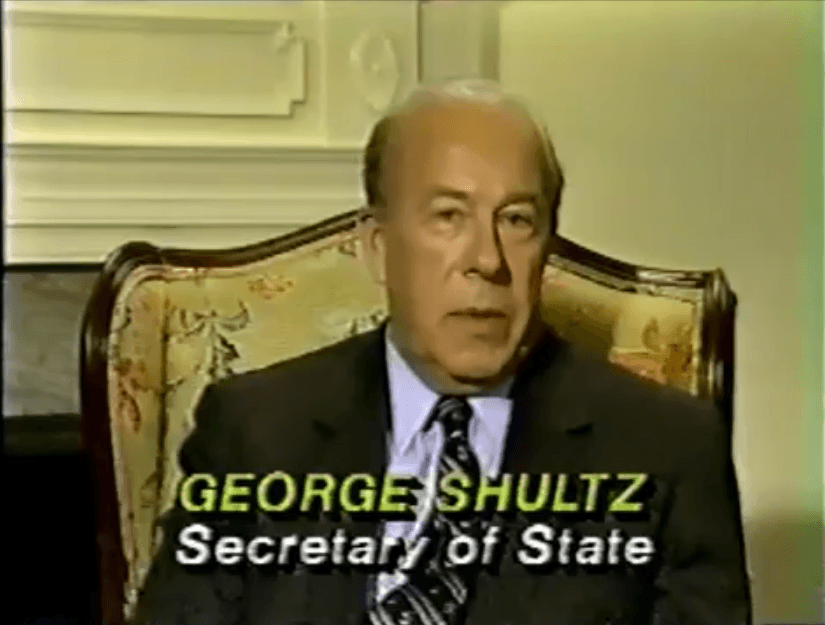
After Shultz spoke, Koppel hosted a televised discussion with a distinguished panel of guests, including former Secretary of State Henry Kissinger, author Elie Wiesel, publisher William F. Buckley, Jr., astronomer Carl Sagan, national security expert Lt. Gen. Brent Scowcroft, and former Defense Secretary Robert McNamara. Their reactions ranged from Buckley’s denunciation of the film as propaganda “that seeks to debilitate the United States,” to Sagan’s comment that a real nuclear war would be even more lethal than depicted in the film because it would be followed by a nuclear winter.
Whatever their intentions, Reagan and Shultz made little progress with the Soviets on nuclear weapons until Gorbachev became General Secretary of the governing Communist Party in March 1985. Immediately afterward, Reagan invited him to a summit. They met in Geneva that November; the meeting was scheduled for 15 minutes but lasted five hours. The next year, in Reykjavik, they came very close to agreeing to destroy all their nuclear weapons, and the director of The Day After received a telegram from the administration telling him, “Don’t think your movie didn’t have any part of this, because it did.” In 1987, the year that The Day After was first shown on Soviet television, the two leaders reached agreement on the Intermediate-Range Nuclear Forces Treaty. By then, as many as 1 billion people may have seen the film.
Today, commentators such as Fox News political anchor Bret Baier and syndicated radio talk-show host Rush Limbaugh claim to see parallels between presidents Ronald Reagan and Donald Trump, and between the Reagan-Gorbachev summit and Trump’s historic summit with North Korean leader Kim Jong-un. Like Reagan, who called the Soviet Union an “evil empire” in a March 1983 address to the National Association of Evangelicals, Trump initially responded to North Korea’s nuclear program with his infamous threat of “fire and fury.”
In the United States and Russia—and now also North Korea—there is still just one person’s finger on the “nuclear button.” When Reagan was president, his first-term chief of staff and other establishment Republicans reportedly feared that Reagan might get the country into a nuclear war. Last year, similar concerns among some of Trump’s fellow Republicans were on public display. Bob Corker, the Republican chairman of the Senate Foreign Relations Committee, for example, told the New York Times that Trump’s reckless threats could put the United States “on the path to World War III.”
In 1983, an opinion poll found that about half of Americans thought they would die in a nuclear war. Although nuclear weapons get a smaller share of press attention today than in 1983, a Gallup poll conducted earlier this year reported that Americans fear the development of nuclear weapons by North Korea more than any other “critical threat,” and a Washington Post-ABC News poll found that “about half of Americans are concerned that President Trump might launch a nuclear attack without justification.” The Global Risks Report 2018, published in January by the World Economic Forum and drawn from a survey of the group’s 1,000 members, warned “the North Korea crisis has arguably brought the world closer than it has been for decades to the possible use of nuclear weapons” and has “created uncertainty about the strength of the norms created by decades of work to prevent nuclear conflict.”
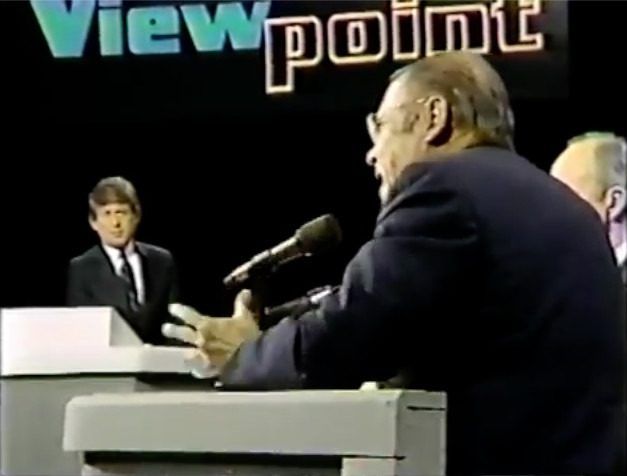
Ted Koppel's Viewpoint
Immediately following The Day After broadcast on November 20, 1983, ABC's Ted Koppel hosted a panel discussion with a Who's Who of international affairs: Henry Kissinger, Brent Scowcroft, Carl Sagan, Elie Wiesel, William F. Buckley, Jr., Robert McNamara, and George Shultz. The Bulletin's editor-in-chief John Mecklin spoke with Koppel about the program and what the public is missing with today's nuclear news.
Immediately following The Day After broadcast on November 20, 1983, ABC's Ted Koppel hosted a panel discussion with a Who's Who of international affairs: Henry Kissinger, Brent Scowcroft, Carl Sagan, Elie Wiesel, William F. Buckley, Jr., Robert McNamara, and George Shultz. The Bulletin's editor-in-chief John Mecklin spoke with Koppel about the program and what the public is missing with today's nuclear news.
JOHN MECKLIN: While I was getting ready to talk to you about this, I was looking at, for random reasons, the Bulletin's analytics. And just about half our readers are 34 or younger, meaning they weren't even born when The Day After aired. So if you can—I don't want to make you into a setup man—but what was the atmosphere like, and why was The Day After such a big deal?
TED KOPPEL: For one thing, in the anticipation of the event, it was enormously controversial. So controversial, in fact, that ABC, the network, came to the news division and said, "We need to do something after the movie." And that's why they came to me, then, and said, "Would you do that Viewpoint?" The point of it being, there were too many people in the country, and Bill Buckley was sort of emblematic of that group, who felt that this was a defeatist film to put out there, that the very act of showing that film would cause the United States to move in the wrong direction, as far as nuclear preparedness was concerned. It might cause people to just sort of throw up their hands in dismay and say, "All is lost, all is lost, it's going to be a total disaster, we have to get rid of all nuclear weapons." That's why the program was scheduled after the movie in the first place.
“It is powerfully done—all $7 mil. worth. It’s very effective & left me greatly depressed.”
More than 50 years after the Nuclear Non-Proliferation Treaty declared the intention of 190 nations (including the United States) “to achieve at the earliest possible date the cessation of the nuclear arms race,” the United States and Russia still have enough weapons to destroy the world many times over—and many of them still stand on hair-trigger alert. Just last month, Gorbachev made an urgent plea for actions to prevent a new arms race.
In Hawaii earlier this year, at the height of tensions between the United States and North Korea, residents received a false ballistic-missile alert over television, radio and cellphones. For 38 minutes, many Hawaiians thought they were about to die. The false alarm reminded some experts of Cold War-era false alarms, the most dangerous of which happened late in September 1983—just two months before The Day After aired. The Soviets’ early-warning system erroneously reported incoming American nuclear missiles, and the gut instincts and wise thinking of a Soviet officer, Col. Stanislav Yevgrafovich Petrov, were all that saved the world from catastrophe.
In early November 1983—less than two weeks before The Day After aired, and less than a month after Reagan saw a preview—NATO conducted a military exercise called Able Archer, which simulated a nuclear attack and included flights by aircraft armed with dummy nuclear warheads. The nonprofit National Security Archive recently published previously-secret Soviet documents showing that “ranking members of Soviet intelligence, military, and the Politburo, to varying degrees, were fearful of a Western first strike in 1983 under the cover of the NATO exercises Autumn Forge 83 and Able Archer 83.” (Autumn Forge, an exercise that airlifted thousands of troops to Europe under radio silence, culminated with the Able Archer simulation.) For the first time, the Soviets put their military on high alert at Polish and East German bases. Like Col. Petrov, Lt. Gen. Leonard Perroots, the deputy chief of staff for intelligence at the US Air Force’s European headquarters, wisely chose not to respond.
It is not inconceivable that something like the 1983 “war scare” could happen again today. In mid-November, the Russian military jammed GPS signals during a NATO military exercise in Norway. CNN called it “the alliance’s largest exercise since the Cold War.”
In addition to the Able Archer simulation, November 1983 was also the month that NATO began deploying US Pershing II missiles to West Germany. The missiles were intended to counter Soviet medium-range missiles capable of striking anywhere in Europe, and there were huge protests in Germany over their deployment. It is no coincidence that nuclear war begins in The Day After with a gradually escalating conflict in Europe. In one scene, viewers hear a Soviet official mention the “coordinated movement of the Pershing II launchers.”
The Intermediate-Range Nuclear Forces (INF) Treaty that Reagan and Gorbachev signed in 1987 resolved that conflict, banning all ground-launched and air-launched nuclear and conventional missiles (and their launchers) with ranges between 500 and 5,500 kilometers, or 310 to 3,420 miles. However, Trump said in October that he plans to withdraw from the treaty, and on December 4 Secretary of State Mike Pompeo said the United States would withdraw in 60 days if Russia continues its alleged non-compliance. Gorbachev and Shultz, in a Washington Post op-ed published that day, warned that “[a]bandoning the INF Treaty would be a step toward a new arms race, undermining strategic stability and increasing the threat of miscalculation or technical failure leading to an immensely destructive war.”
The United States first accused Russia of violating the treaty in 2014, by testing a banned cruise missile, and later claimed that Russia had deployed such a missile. However, the United States has not yet divulged details about the alleged violation, and there are no arms control talks currently scheduled.
“The one meaningful thing that Trump is doing is trying to get a dialogue going with Putin,” said former Defense Secretary (and chair of the Bulletin‘s Board of Sponsors) William J. Perry at the Bulletin’s annual dinner in Chicago on November 8. But Russia’s refusal to release Ukrainian Navy ships and sailors seized in the Kerch Strait in late November led Trump to cancel a scheduled meeting with Putin at the recent G20 Summit in Argentina, where they had been expected to discuss the fate of both the INF and another treaty for which Reagan and Gorbachev laid the groundwork in Reykjavik: New START, which capped the number of nuclear warheads on deployed intercontinental ballistic missiles (ICBMs), deployed submarine-launched ballistic missiles, and deployed heavy bombers. Nuclear experts worry that Trump will let New START expire in February 2021, if only because it is one of President Barack Obama’s signature achievements, at which point there would no longer be any international agreements governing US and Russian nuclear arsenals for the first time in almost 50 years.
More than 50 years after the Nuclear Non-Proliferation Treaty declared the intention of 190 nations (including the United States) “to achieve at the earliest possible date the cessation of the nuclear arms race,” the United States and Russia still have enough weapons to destroy the world many times over—and many of them still stand on hair-trigger alert. Just last month, Gorbachev made an urgent plea for actions to prevent a new arms race.
In Hawaii earlier this year, at the height of tensions between the United States and North Korea, residents received a false ballistic-missile alert over television, radio and cellphones. For 38 minutes, many Hawaiians thought they were about to die. The false alarm reminded some experts of Cold War-era false alarms, the most dangerous of which happened late in September 1983—just two months before The Day After aired. The Soviets’ early-warning system erroneously reported incoming American nuclear missiles, and the gut instincts and wise thinking of a Soviet officer, Col. Stanislav Yevgrafovich Petrov, were all that saved the world from catastrophe.
In early November 1983—less than two weeks before The Day After aired, and less than a month after Reagan saw a preview—NATO conducted a military exercise called Able Archer, which simulated a nuclear attack and included flights by aircraft armed with dummy nuclear warheads. The nonprofit National Security Archive recently published previously-secret Soviet documents showing that “ranking members of Soviet intelligence, military, and the Politburo, to varying degrees, were fearful of a Western first strike in 1983 under the cover of the NATO exercises Autumn Forge 83 and Able Archer 83.” (Autumn Forge, an exercise that airlifted thousands of troops to Europe under radio silence, culminated with the Able Archer simulation.) For the first time, the Soviets put their military on high alert at Polish and East German bases. Like Col. Petrov, Lt. Gen. Leonard Perroots, the deputy chief of staff for intelligence at the US Air Force’s European headquarters, wisely chose not to respond.
It is not inconceivable that something like the 1983 “war scare” could happen again today. In mid-November, the Russian military jammed GPS signals during a NATO military exercise in Norway. CNN called it “the alliance’s largest exercise since the Cold War.”
In addition to the Able Archer simulation, November 1983 was also the month that NATO began deploying US Pershing II missiles to West Germany. The missiles were intended to counter Soviet medium-range missiles capable of striking anywhere in Europe, and there were huge protests in Germany over their deployment. It is no coincidence that nuclear war begins in The Day After with a gradually escalating conflict in Europe. In one scene, viewers hear a Soviet official mention the “coordinated movement of the Pershing II launchers.”
The Intermediate-Range Nuclear Forces (INF) Treaty that Reagan and Gorbachev signed in 1987 resolved that conflict, banning all ground-launched and air-launched nuclear and conventional missiles (and their launchers) with ranges between 500 and 5,500 kilometers, or 310 to 3,420 miles. However, Trump said in October that he plans to withdraw from the treaty, and on December 4 Secretary of State Mike Pompeo said the United States would withdraw in 60 days if Russia continues its alleged non-compliance. Gorbachev and Shultz, in a Washington Post op-ed published that day, warned that “[a]bandoning the INF Treaty would be a step toward a new arms race, undermining strategic stability and increasing the threat of miscalculation or technical failure leading to an immensely destructive war.”
The United States first accused Russia of violating the treaty in 2014, by testing a banned cruise missile, and later claimed that Russia had deployed such a missile. However, the United States has not yet divulged details about the alleged violation, and there are no arms control talks currently scheduled.
“The one meaningful thing that Trump is doing is trying to get a dialogue going with Putin,” said former Defense Secretary (and chair of the Bulletin‘s Board of Sponsors) William J. Perry at the Bulletin’s annual dinner in Chicago on November 8. But Russia’s refusal to release Ukrainian Navy ships and sailors seized in the Kerch Strait in late November led Trump to cancel a scheduled meeting with Putin at the recent G20 Summit in Argentina, where they had been expected to discuss the fate of both the INF and another treaty for which Reagan and Gorbachev laid the groundwork in Reykjavik: New START, which capped the number of nuclear warheads on deployed intercontinental ballistic missiles (ICBMs), deployed submarine-launched ballistic missiles, and deployed heavy bombers. Nuclear experts worry that Trump will let New START expire in February 2021, if only because it is one of President Barack Obama’s signature achievements, at which point there would no longer be any international agreements governing US and Russian nuclear arsenals for the first time in almost 50 years.
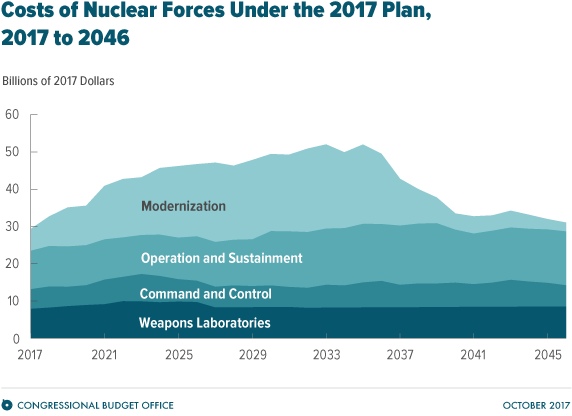
In an October 2017 report, the Congressional Budget Office estimated that the Obama administration’s 2017 plans for nuclear forces would cost $1.2 trillion over the 2017–2046 period. CBO

This attack sequence in The Day After shocked viewers across the country—from Denver (below) to Camp David, where President Ronald Reagan received an early screening.
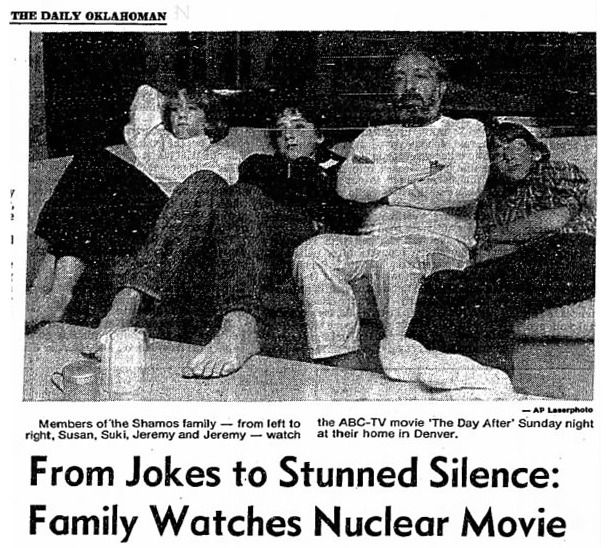

When Obama visited the University of Kansas in 2015, he said nothing about nuclear weapons; he spoke of middle-class economics and basketball. Although Obama won a Nobel Peace Prize largely for his vision of a world free of nuclear weapons, he nevertheless bequeathed to Trump a 30-year plan to “modernize” the US nuclear arsenal. Based on a Congressional Budget Office report, the Arms Control Association estimates that the United States will spend about $1.2 trillion in inflation-adjusted dollars by 2046 on new bombs, missiles, bombers, submarines, and related systems. The Trump administration’s 2018 Nuclear Posture Review calls for a new generation of land-based ICBMs, which experts such as Perry view as an unnecessary and risky component of a nuclear triad that also includes sea- and air-launched nuclear weapons.
In 1983, the McConnell Air Force Base in Kansas was home to 18 Titan II missiles, the largest ICBM ever deployed by the US Air Force. Reagan was proposing to install the Peacekeeper missile, America’s most controversial ICBM, in Titan II silos and on mobile transporters. Even closer to Lawrence was the Whiteman Air Force Base, east of Kansas City in Missouri, where 150 Minuteman II missiles were deployed.
 In The Day After, Minuteman missiles erupt from the plains near farmhouses, and people who see the missile trails above the football stadium and the South Park gazebo in Lawrence understand that a hail of Russian ICBMs will soon follow. There is panic in the streets. When the Russian missiles targeted at Kansas City detonate during the movie’s extended attack sequence, flashing brightly and sending up mushroom clouds, viewers see snippets of footage from actual nuclear tests interspersed with a horrifying, rapid-fire series of “skeletonized” people instantly killed in the midst of everyday activities.
In The Day After, Minuteman missiles erupt from the plains near farmhouses, and people who see the missile trails above the football stadium and the South Park gazebo in Lawrence understand that a hail of Russian ICBMs will soon follow. There is panic in the streets. When the Russian missiles targeted at Kansas City detonate during the movie’s extended attack sequence, flashing brightly and sending up mushroom clouds, viewers see snippets of footage from actual nuclear tests interspersed with a horrifying, rapid-fire series of “skeletonized” people instantly killed in the midst of everyday activities.
The United States no longer deploys ICBMs near Kansas City. The force has shrunk by about 60 percent, to around 400 missiles now deployed near Air Force bases in Montana, North Dakota, and Wyoming. That’s good news for the people of Lawrence.
The bad news, however, is that the latest Nuclear Posture Review calls for the development of new and dangerous weapons: a new sea-launched cruise missile and a “low-yield” nuclear warhead that could be more “useable” than bigger bombs—and arguably more likely to make military strategists see a nuclear war as winnable rather than suicidal. The United States might even use such a weapon in response to a non-nuclear threat, such as a cyberattack. And Trump seems to be as enamored of his proposed “Space Force” as Reagan was of his “Star Wars” Strategic Defense Initiative.
The Defense Department claims it needs new weapons to respond to new threats from Russia, where Putin in 2016 vowed to modernize its own nuclear weapons to “reliably penetrate any existing and prospective missile defense systems.” More recently, Putin has bragged about deploying hypersonic missiles capable of traveling at many times the speed of sound “in coming months,” and developing both a global-range, nuclear-powered cruise missile and an underwater nuclear drone. The Russians say they have been forced into these actions by the eastward expansion of NATO and the installation of missile defense systems in Europe. Russia is also developing the world’s biggest missile—so big it could theoretically fly over the South Pole and avoid US missile defenses.
The rash of new threats makes some experts wonder whether the United States and Russia are serious about resolving their differences over the INF Treaty and other matters—or just looking for excuses to lunge into a new arms race. “The opponents of arms control have won,” says Steven E. Miller, director of the International Security Program at Harvard’s Belfer Center for Science and International Affairs (and a member of the Bulletin’s Science and Security Board). “By the end of the 1990s, we had a nuclear order that was internationally regulated and jointly managed. Right now, we're literally on the edge of having nothing left with regard to nuclear restraint. The case for arms control has to be fought all over again.”
When Obama visited the University of Kansas in 2015, he said nothing about nuclear weapons; he spoke of middle-class economics and basketball. Although Obama won a Nobel Peace Prize largely for his vision of a world free of nuclear weapons, he nevertheless bequeathed to Trump a 30-year plan to “modernize” the US nuclear arsenal. Based on a Congressional Budget Office report, the Arms Control Association estimates that the United States will spend about $1.2 trillion in inflation-adjusted dollars by 2046 on new bombs, missiles, bombers, submarines, and related systems. The Trump administration’s 2018 Nuclear Posture Review calls for a new generation of land-based ICBMs, which experts such as Perry view as an unnecessary and risky component of a nuclear triad that also includes sea- and air-launched nuclear weapons.
In 1983, the McConnell Air Force Base in Kansas was home to 18 Titan II missiles, the largest ICBM ever deployed by the US Air Force. Reagan was proposing to install the Peacekeeper missile, America’s most controversial ICBM, in Titan II silos and on mobile transporters. Even closer to Lawrence was the Whiteman Air Force Base, east of Kansas City in Missouri, where 150 Minuteman II missiles were deployed.
In The Day After, Minuteman missiles erupt from the plains near farmhouses, and people who see the missile trails above the football stadium and the South Park gazebo in Lawrence understand that a hail of Russian ICBMs will soon follow. There is panic in the streets. When the Russian missiles targeted at Kansas City detonate during the movie’s extended attack sequence, flashing brightly and sending up mushroom clouds, viewers see snippets of footage from actual nuclear tests interspersed with a horrifying, rapid-fire series of “skeletonized” people instantly killed in the midst of everyday activities.
The United States no longer deploys ICBMs near Kansas City. The force has shrunk by about 60 percent, to around 400 missiles now deployed near Air Force bases in Montana, North Dakota, and Wyoming. That’s good news for the people of Lawrence.
The bad news, however, is that the latest Nuclear Posture Review calls for the development of new and dangerous weapons: a new sea-launched cruise missile and a “low-yield” nuclear warhead that could be more “useable” than bigger bombs—and arguably more likely to make military strategists see a nuclear war as winnable rather than suicidal. The United States might even use such a weapon in response to a non-nuclear threat, such as a cyberattack. And Trump seems to be as enamored of his proposed “Space Force” as Reagan was of his “Star Wars” Strategic Defense Initiative.
The Defense Department claims it needs new weapons to respond to new threats from Russia, where Putin in 2016 vowed to modernize its own nuclear weapons to “reliably penetrate any existing and prospective missile defense systems.” More recently, Putin has bragged about deploying hypersonic missiles capable of traveling at many times the speed of sound “in coming months,” and developing both a global-range, nuclear-powered cruise missile and an underwater nuclear drone. The Russians say they have been forced into these actions by the eastward expansion of NATO and the installation of missile defense systems in Europe. Russia is also developing the world’s biggest missile—so big it could theoretically fly over the South Pole and avoid US missile defenses.
The rash of new threats makes some experts wonder whether the United States and Russia are serious about resolving their differences over the INF Treaty and other matters—or just looking for excuses to lunge into a new arms race. “The opponents of arms control have won,” says Steven E. Miller, director of the International Security Program at Harvard’s Belfer Center for Science and International Affairs (and a member of the Bulletin’s Science and Security Board). “By the end of the 1990s, we had a nuclear order that was internationally regulated and jointly managed. Right now, we're literally on the edge of having nothing left with regard to nuclear restraint. The case for arms control has to be fought all over again.”
When Obama visited the University of Kansas in 2015, he said nothing about nuclear weapons; he spoke of middle-class economics and basketball. Although Obama won a Nobel Peace Prize largely for his vision of a world free of nuclear weapons, he nevertheless bequeathed to Trump a 30-year plan to “modernize” the US nuclear arsenal. Based on a Congressional Budget Office report, the Arms Control Association estimates that the United States will spend about $1.2 trillion in inflation-adjusted dollars by 2046 on new bombs, missiles, bombers, submarines, and related systems. The Trump administration’s 2018 Nuclear Posture Review calls for a new generation of land-based ICBMs, which experts such as Perry view as an unnecessary and risky component of a nuclear triad that also includes sea- and air-launched nuclear weapons.
In 1983, the McConnell Air Force Base in Kansas was home to 18 Titan II missiles, the largest ICBM ever deployed by the US Air Force. Reagan was proposing to install the Peacekeeper missile, America’s most controversial ICBM, in Titan II silos and on mobile transporters. Even closer to Lawrence was the Whiteman Air Force Base, east of Kansas City in Missouri, where 150 Minuteman II missiles were deployed.
In The Day After, Minuteman missiles erupt from the plains near farmhouses, and people who see the missile trails above the football stadium and the South Park gazebo in Lawrence understand that a hail of Russian ICBMs will soon follow. There is panic in the streets. When the Russian missiles targeted at Kansas City detonate during the movie’s extended attack sequence, flashing brightly and sending up mushroom clouds, viewers see snippets of footage from actual nuclear tests interspersed with a horrifying, rapid-fire series of “skeletonized” people instantly killed in the midst of everyday activities.

The United States no longer deploys ICBMs near Kansas City. The force has shrunk by about 60 percent, to around 400 missiles now deployed near Air Force bases in Montana, North Dakota, and Wyoming. That’s good news for the people of Lawrence.
The bad news, however, is that the latest Nuclear Posture Review calls for the development of new and dangerous weapons: a new sea-launched cruise missile and a “low-yield” nuclear warhead that could be more “useable” than bigger bombs—and arguably more likely to make military strategists see a nuclear war as winnable rather than suicidal. The United States might even use such a weapon in response to a non-nuclear threat, such as a cyberattack. And Trump seems to be as enamored of his proposed “Space Force” as Reagan was of his “Star Wars” Strategic Defense Initiative.
The Defense Department claims it needs new weapons to respond to new threats from Russia, where Putin in 2016 vowed to modernize its own nuclear weapons to “reliably penetrate any existing and prospective missile defense systems.” More recently, Putin has bragged about deploying hypersonic missiles capable of traveling at many times the speed of sound “in coming months,” and developing both a global-range, nuclear-powered cruise missile and an underwater nuclear drone. The Russians say they have been forced into these actions by the eastward expansion of NATO and the installation of missile defense systems in Europe. Russia is also developing the world’s biggest missile—so big it could theoretically fly over the South Pole and avoid US missile defenses.
The rash of new threats makes some experts wonder whether the United States and Russia are serious about resolving their differences over the INF Treaty and other matters—or just looking for excuses to lunge into a new arms race. “The opponents of arms control have won,” says Steven E. Miller, director of the International Security Program at Harvard’s Belfer Center for Science and International Affairs (and a member of the Bulletin’s Science and Security Board). “By the end of the 1990s, we had a nuclear order that was internationally regulated and jointly managed. Right now, we're literally on the edge of having nothing left with regard to nuclear restraint. The case for arms control has to be fought all over again.”
Louise Hanson, who is now 78 years old, has been pushing for arms control for most of her adult life. She and her 79-year-old husband Allan, a now-retired professor of anthropology at the University of Kansas, remember being terrified newlyweds listening to news of the 1962 Cuban Missile Crisis on their car radio at night in Chicago. After they moved to Lawrence, they became leaders in the Lawrence Coalition for Peace and Justice, a group that formed in the 1970s and by 1983 was focused on nuclear weapons. Louise once wrote to her senator, Bob Dole, on 1,000 consecutive days, each time giving him a new reason to halt the nuclear arms race. Today, the Hansons—quick-witted, gracious, and younger-looking than their years—live in a tasteful downtown loft one block from the disaster-struck street that appeared in The Day After.
When the movie came to town, the Coalition recognized it as a golden opportunity. Allan and Louise—she played a “suffering victim” as an extra and elicited a scream from her high-school daughter when she came home in her movie makeup—helped create a local campaign around the movie called “Let Lawrence Live.” They got some unexpected help from a brash, young media strategist named Josh Baran, whose only previous experience was working for the Nuclear Freeze campaign in California. With a budget of only about $50,000 from the Rockefeller Family Fund, Baran and Mark Graham (now director of the Wayback Machine at the Internet Archive) helped make The Day After a national sensation.
Baran and The Day After director Nicholas Meyer had friends in common in California, and one of them made introductions. Baran went to Meyer’s house, saw the film (which was still a work in progress), and took home a copy. When I interviewed Baran by phone last month, he said Meyer told him to “do what you want with it, and don’t tell me.” What Baran did was to create a major publicity campaign for an ABC movie ... without ABC’s knowledge or consent. Nowadays this would be called “hijack marketing”: taking advantage of someone else’s event to generate publicity for your own cause. But in 1983, “no one had ever done it,” claims Baran, who now heads Baran Strategies in New York City. “It was a very far out-of-the-box strategy.”

Baran traveled around the country, stimulating interest in the forthcoming film among activists and reporters and planning activities around it. “It took off like gangbusters,” he recalls. “About halfway through, I told ABC what I was doing, and they freaked out.” But there was little the network could do about all the free publicity they were getting from Baran.
He attributes the success of the movie to several factors that would be difficult to replicate today. One was that there were only three television networks in 1983, so programs reached a much broader audience. “I would not have wanted to make this as a feature film,” Meyer told the New York Times a week before the film aired. “I did not want to preach to the converted. I wanted to reach the guy who’s waiting for The Flying Nun to come on.”
Retired theater professor Jack Wright doubts that such a movie could appear today on television. “I think we’re so politically ostracized now that I don’t know that we could ever have another event like we had in The Day After,” he says. “The groups now are so politicized that they would stop it.”
In 1983, putting the movie on television ensured that it would spark a national conversation, because it would be seen simultaneously by millions of people. Bringing the movie into people’s homes was “was genius really,” says Louise Hanson, “because it made it much more intimate.”
The Day After also benefited from good timing. Jonathan Schell’s seminal 1982 book The Fate of the Earth had awakened readers to the unthinkable prospect of a nuclear war that would devastate most life on the planet. The Nuclear Freeze movement was in full swing; a referendum in Lawrence during the November 1982 election received support from 74 percent of voters. Nuclear war was the number one concern preoccupying the nation. The Lawrence Coalition for Peace and Justice was holding events around town, like a rally at South Park where they released “balloons not bombs.” The park appears briefly in The Day After, with just-launched missiles visible in the sky above the bandstand. Louise Hanson says she can’t go by that bandstand, even to this day, without seeing those missiles in her mind’s eye.
The film did not significantly increase public support for nuclear arms reductions, but research suggests that it may have made viewers more knowledgeable about nuclear war and caused them to think about it more. For viewers who didn’t want to think about nuclear war, perhaps the biggest emotional punch delivered by the movie was the scene in which a husband drags his screaming wife—who is insisting on making the bed, in a desperate attempt to maintain normality—to their basement shelter.
Has it made any difference? That’s what the Hansons wonder now, 35 years after the movie and the height of the peace movement in Lawrence, as they play a song by a local group for me on their living-room stereo: “Uprising,” the anthem of the local coalition, which has a line that Louise loves: “I feel it in my bones.” The Hansons find it alarming that a fictional movie might have played a key role in changing a president’s views. “We in the peace movement have been, for decades, dangerously close to patting ourselves on the head and being satisfied with consciousness raising,” Louise says. “I see that as hugely insufficient unless you can translate it into policy.”
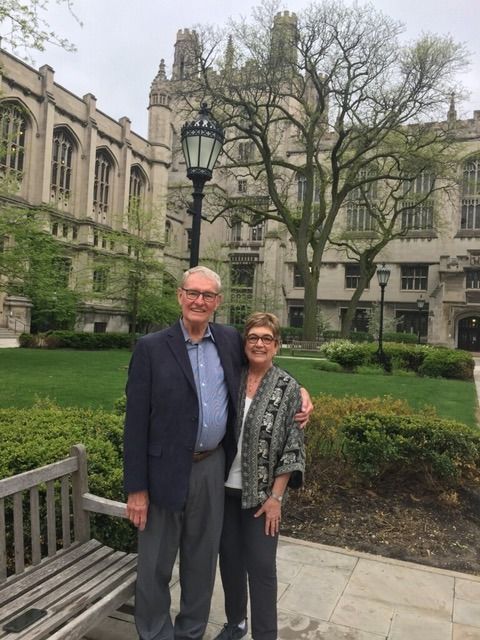
Above: Allan and Louise Hanson in 2017 at the University of Chicago, where he was a graduate student during the first few years of their marriage.
Below: Announcement for a "candlelight gathering," printed in the Lawrence Journal-World classifieds the day before The Day After broadcast. Campanile Hill is adjacent to the University of Kansas stadium featured in the film.
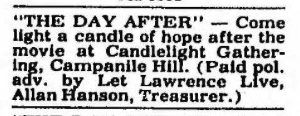
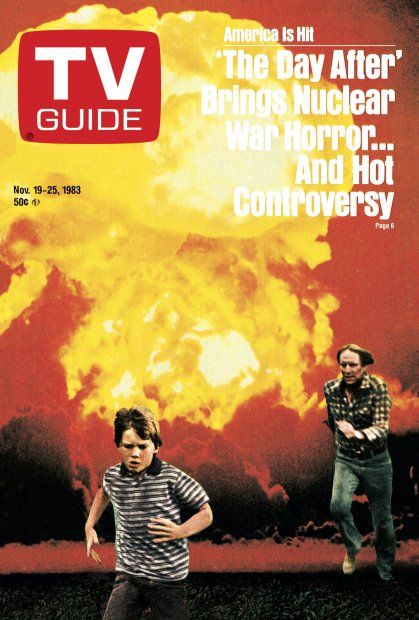
“About halfway through, I told ABC what I was doing, and they freaked out.”
Bob Swan, Jr., a genial man with warm blue eyes who has befriended many Russian athletes and met a number of Russian dignitaries, including Mikhail Gorbachev and Boris Yeltsin, is hopeful that citizen diplomacy can fill some of the gaps in policy making. He sees lots of connections between Kansas and Russia, everything from the red winter wheat brought to Kansas by Russian Mennonites, to the American and Soviet soldiers who met and embraced at the Elbe River in April 1945 on their way to jointly defeating Nazi Germany. (He proposed and helped organize a 40th anniversary celebration of the meetup in Torgau, Germany, for veterans of both armies.)
A few months after The Day After began filming, Swan founded the first of several groups dedicated to improving relations between Americans and Russians. He called it Athletes United for Peace. The goal was to promote athletic competition instead of nuclear hostility. When I visited him in August, the dining-room table in his home was covered with neatly stacked papers and memorabilia documenting his persistent efforts during the 1980s and ‘90s (the University of Kansas research library has 37 boxes of material from Swan in its archives). He thought he had “retired” from the volunteer work that had consumed so much of his time—and his first marriage—during those years, but now he is thinking about a possible comeback.
Swan met his current wife, Irina Turenko, in 2002 during one of several dozen trips he made to Russia. She was in Russia visiting family when I met Swan at their home, but he showed me a picture from their wedding day in 2006; he and Irina are standing between an American flag and a Russian one. Swan had another visitor on the day I was there: his sharp-tongued fraternity brother Mark Scott, who speaks fluent Russian and was in Lawrence for medical treatment. In 1982, Scott came up with the idea to invite a delegation of Soviet athletes to participate in the Kansas Relays, a three-day track-and-field meet that has been held at the University of Kansas every April since 1923.
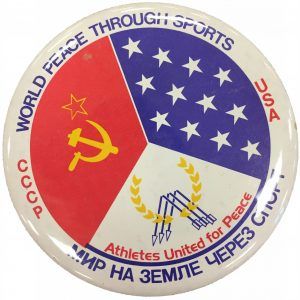 Former mayor David Longhurst remembers attending the 1983 reception for the athletes. It was awkward. The Kansans and the Soviets viewed each other with suspicion. Longhurst didn’t speak Russian, and the visitors didn’t speak English. “I was trying to talk to a Soviet shot putter, and we weren’t communicating at all,” Longhurst recalls. “I took out my wallet and showed him a picture of my son. He took out his wallet and showed me a picture of his kids. All of a sudden, we understood one another. The barrier just melted.”
Former mayor David Longhurst remembers attending the 1983 reception for the athletes. It was awkward. The Kansans and the Soviets viewed each other with suspicion. Longhurst didn’t speak Russian, and the visitors didn’t speak English. “I was trying to talk to a Soviet shot putter, and we weren’t communicating at all,” Longhurst recalls. “I took out my wallet and showed him a picture of my son. He took out his wallet and showed me a picture of his kids. All of a sudden, we understood one another. The barrier just melted.”
The next day, at the start of the “friendship relays,” Longhurst told the story to the crowd in his welcoming remarks. He said it had occurred to him that it would be wonderful if the leaders of the United States and the Soviet Union could meet in “a place like Lawrence” and discover how much they had in common. “The press got hold of that and went nuts,” says Longhurst. The headlines said he had invited the two leaders to come to Lawrence.
Some of his constituents were so enthusiastic about the idea that they launched a campaign to organize what became known as the Meeting for Peace. Dole and other politicians endorsed the initiative. Longhurst and Swan joined a delegation of schoolchildren (including 10-year-old actress Ellen Anthony) that traveled by train to Washington to deliver thousands of postcards to the White House and the Soviet embassy, asking the nations’ leaders to come to Lawrence.
It took Swan and others more than seven years to make it happen, but the Meeting for Peace was finally held in Lawrence and six other Kansas cities in October 1990. By then, it had become a “people-to-people” event rather than a summit. About 300 prestigious Soviet citizens from a variety of regions and backgrounds—including the son of former Soviet premier Nikita Khrushchev—visited Kansas to attend conferences and art shows, stay with Kansas families, celebrate the 100th birthday of Kansas-raised President Dwight D. Eisenhower (a big proponent of people-to-people exchanges to promote international understanding and friendship), and “bury an era” (as a New York Times headline reported). At the opening assembly, the Kansans and their guests applauded wildly when it was announced that Gorbachev had been awarded the Nobel Peace Prize.
After Trump’s inauguration, Swan wrote a long letter to the president and his foreign policy team, proposing a number of ideas for what he called “a remarkable opportunity to improve US-Russia relations,” but he received only a very general reply six months later. Today, Swan remains hopeful about better relations between the two superpowers but says “it’s got to be from the bottom up this time, because our political system is in such disarray.” He hopes that young people will lead a fresh effort to improve relations between Russia and the United States, but it saddens him that “we’ve already done this.”
Bob Swan, Jr., a genial man with warm blue eyes who has befriended many Russian athletes and met a number of Russian dignitaries, including Mikhail Gorbachev and Boris Yeltsin, is hopeful that citizen diplomacy can fill some of the gaps in policy making. He sees lots of connections between Kansas and Russia, everything from the red winter wheat brought to Kansas by Russian Mennonites, to the American and Soviet soldiers who met and embraced at the Elbe River in April 1945 on their way to jointly defeating Nazi Germany. (He proposed and helped organize a 40th anniversary celebration of the meetup in Torgau, Germany, for veterans of both armies.)
A few months after The Day After began filming, Swan founded the first of several groups dedicated to improving relations between Americans and Russians. He called it Athletes United for Peace. The goal was to promote athletic competition instead of nuclear hostility. When I visited him in August, the dining-room table in his home was covered with neatly stacked papers and memorabilia documenting his persistent efforts during the 1980s and ‘90s (the University of Kansas research library has 37 boxes of material from Swan in its archives). He thought he had “retired” from the volunteer work that had consumed so much of his time—and his first marriage—during those years, but now he is thinking about a possible comeback.
Swan met his current wife, Irina Turenko, in 2002 during one of several dozen trips he made to Russia. She was in Russia visiting family when I met Swan at their home, but he showed me a picture from their wedding day in 2006; he and Irina are standing between an American flag and a Russian one. Swan had another visitor on the day I was there: his sharp-tongued fraternity brother Mark Scott, who speaks fluent Russian and was in Lawrence for medical treatment. In 1982, Scott came up with the idea to invite a delegation of Soviet athletes to participate in the Kansas Relays, a three-day track-and-field meet that has been held at the University of Kansas every April since 1923.
 Former mayor David Longhurst remembers attending the 1983 reception for the athletes. It was awkward. The Kansans and the Soviets viewed each other with suspicion. Longhurst didn’t speak Russian, and the visitors didn’t speak English. “I was trying to talk to a Soviet shot putter, and we weren’t communicating at all,” Longhurst recalls. “I took out my wallet and showed him a picture of my son. He took out his wallet and showed me a picture of his kids. All of a sudden, we understood one another. The barrier just melted.”
Former mayor David Longhurst remembers attending the 1983 reception for the athletes. It was awkward. The Kansans and the Soviets viewed each other with suspicion. Longhurst didn’t speak Russian, and the visitors didn’t speak English. “I was trying to talk to a Soviet shot putter, and we weren’t communicating at all,” Longhurst recalls. “I took out my wallet and showed him a picture of my son. He took out his wallet and showed me a picture of his kids. All of a sudden, we understood one another. The barrier just melted.”
The next day, at the start of the “friendship relays,” Longhurst told the story to the crowd in his welcoming remarks. He said it had occurred to him that it would be wonderful if the leaders of the United States and the Soviet Union could meet in “a place like Lawrence” and discover how much they had in common. “The press got hold of that and went nuts,” says Longhurst. The headlines said he had invited the two leaders to come to Lawrence.
Some of his constituents were so enthusiastic about the idea that they launched a campaign to organize what became known as the Meeting for Peace. Dole and other politicians endorsed the initiative. Longhurst and Swan joined a delegation of schoolchildren (including 10-year-old actress Ellen Anthony) that traveled by train to Washington to deliver thousands of postcards to the White House and the Soviet embassy, asking the nations’ leaders to come to Lawrence.
It took Swan and others more than seven years to make it happen, but the Meeting for Peace was finally held in Lawrence and six other Kansas cities in October 1990. By then, it had become a “people-to-people” event rather than a summit. About 300 prestigious Soviet citizens from a variety of regions and backgrounds—including the son of former Soviet premier Nikita Khrushchev—visited Kansas to attend conferences and art shows, stay with Kansas families, celebrate the 100th birthday of Kansas-raised President Dwight D. Eisenhower (a big proponent of people-to-people exchanges to promote international understanding and friendship), and “bury an era” (as a New York Times headline reported). At the opening assembly, the Kansans and their guests applauded wildly when it was announced that Gorbachev had been awarded the Nobel Peace Prize.
After Trump’s inauguration, Swan wrote a long letter to the president and his foreign policy team, proposing a number of ideas for what he called “a remarkable opportunity to improve US-Russia relations,” but he received only a very general reply six months later. Today, Swan remains hopeful about better relations between the two superpowers but says “it’s got to be from the bottom up this time, because our political system is in such disarray.” He hopes that young people will lead a fresh effort to improve relations between Russia and the United States, but it saddens him that “we’ve already done this.”
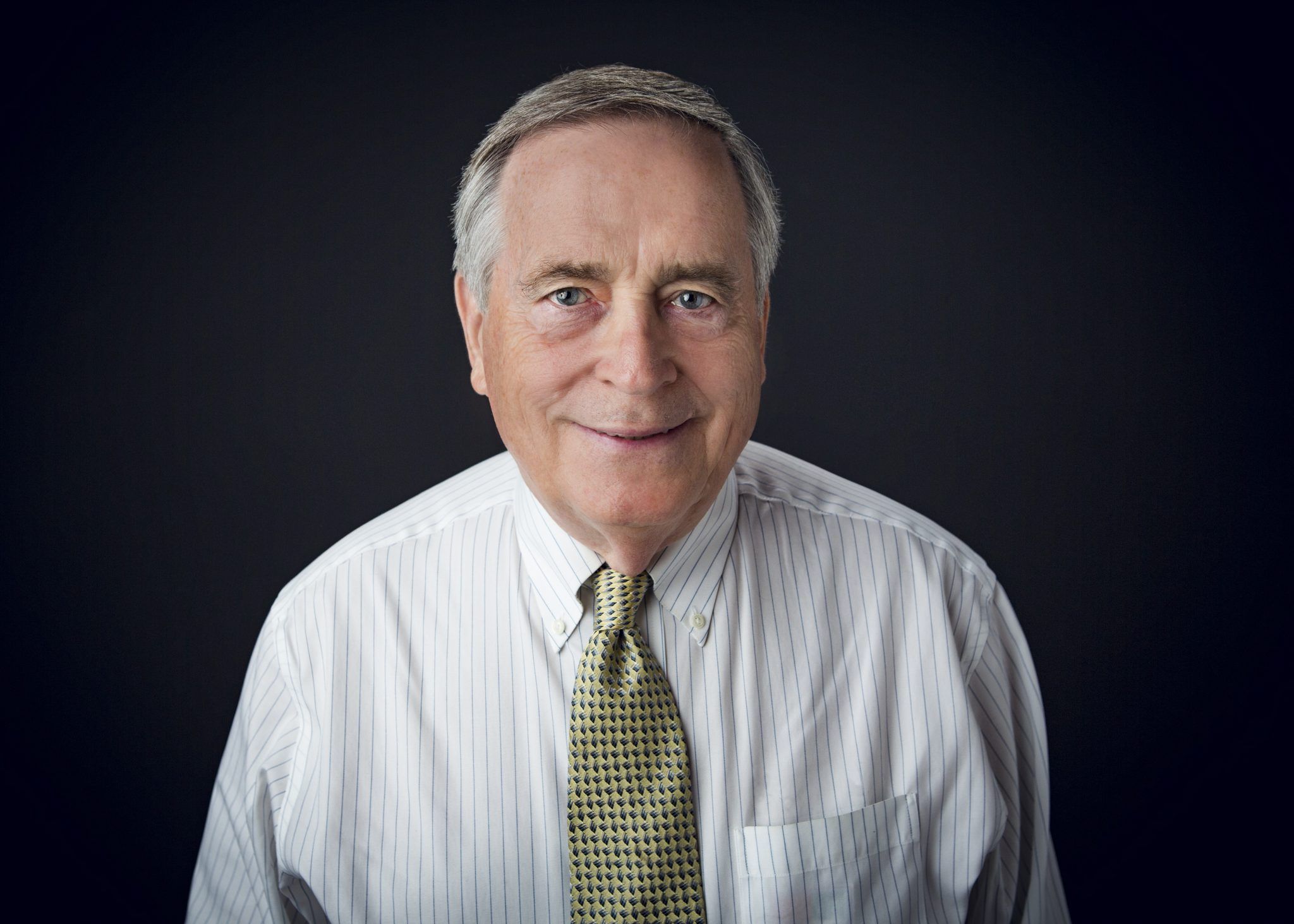
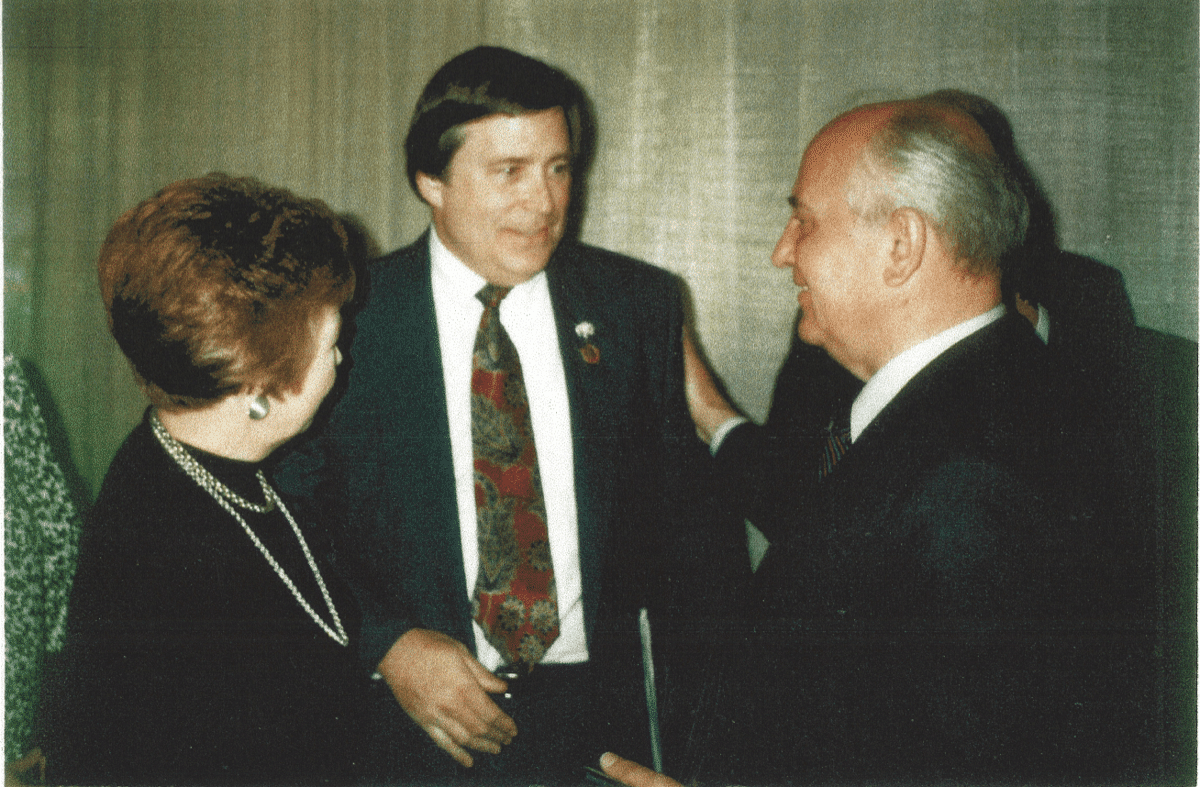
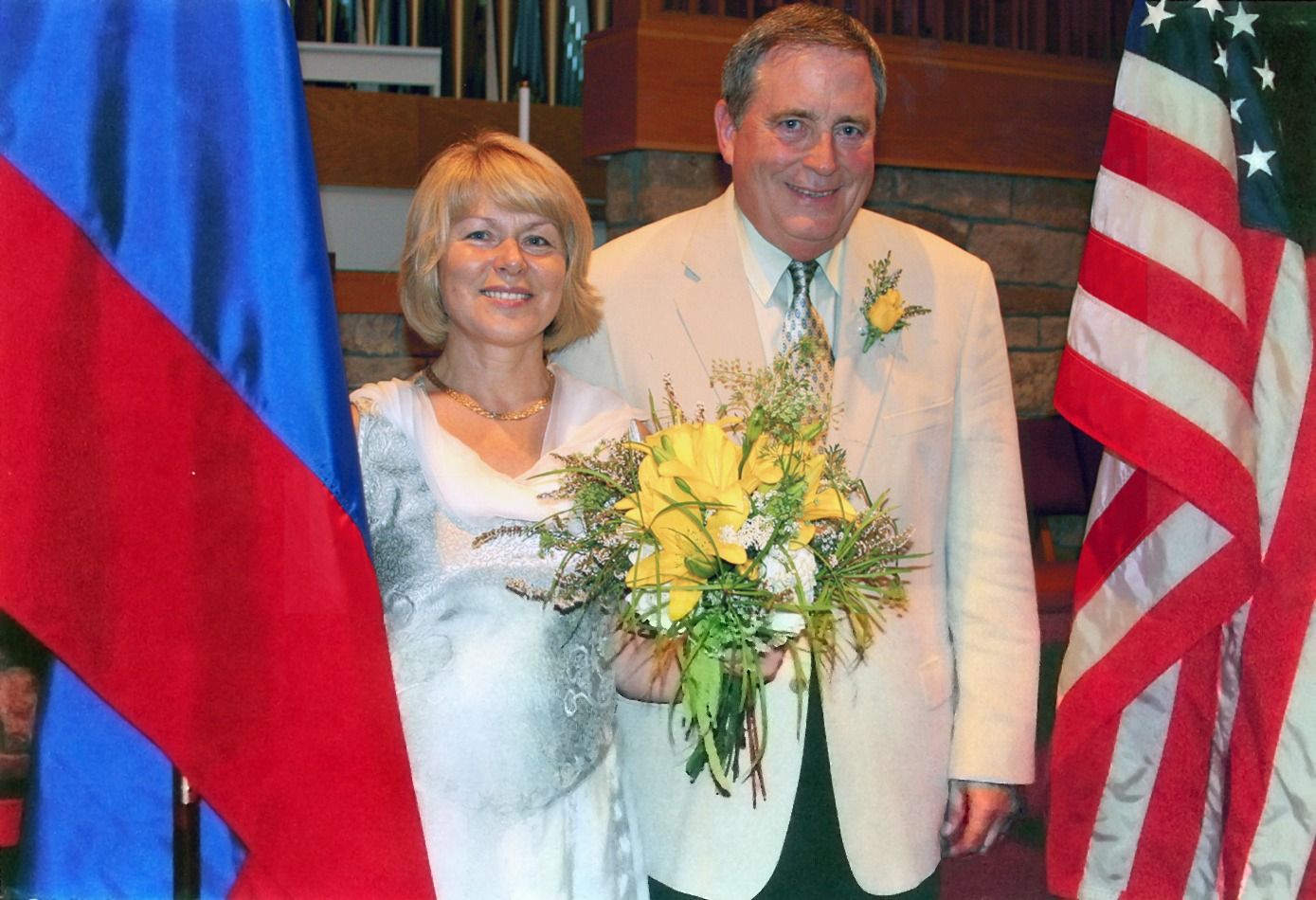
Top: Bob Swan, Jr.
Middle: Mikhail and Raisa Gorbachev greet Bob Swan, Jr. at a private luncheon before Gorbachev's speech in Fulton, Missouri on May 6, 1992.
Above: Irina Turenko and Bob Swan, Jr. at their wedding in 2006. Nick Swan
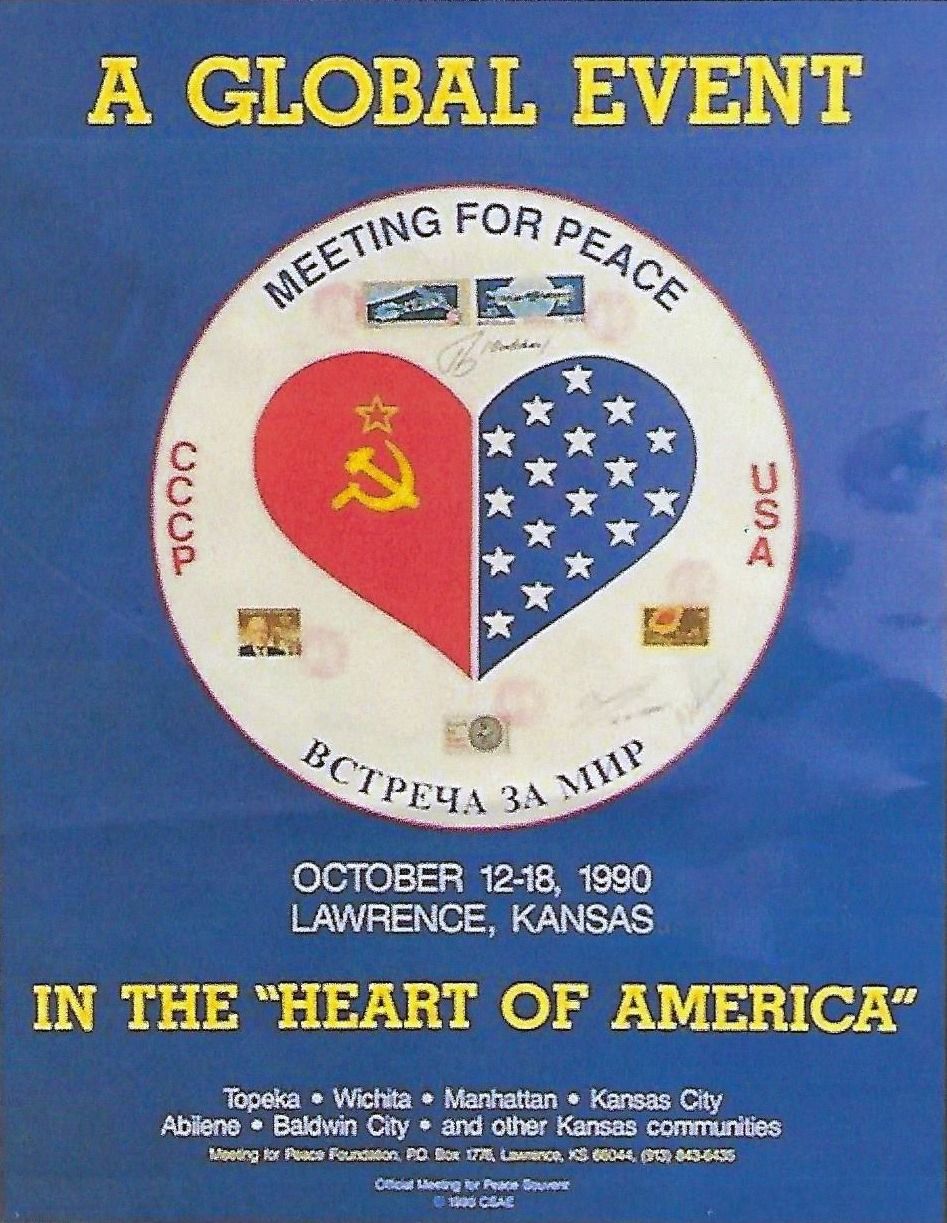
A BRIGHT TOMORROW?
In one scene in The Day After, a pregnant woman who has taken shelter in the Lawrence hospital along with fallout victims tells her doctor that her overdue baby doesn’t want to be born. You’re holding back hope, he says.
“Hope for what?” she asks. “We knew the score. We knew all about bombs. We knew all about fallout. We knew this could happen for 40 years. Nobody was interested.”
It won’t be long before another 40 years have passed. Americans have not yet perished in a nuclear war or its aftermath, but a new arms race is beginning and the potential for an intentional or accidental nuclear war seems to be rising. As Koppel said in his introduction to the panel discussion that followed The Day After, “There is some good news. If you can, take a quick look out the window. It’s all still there.” But, he asked, “Is the vision that we’ve just seen the future as it will be, or only as it may be? Is there still time?”
The poet Langston Hughes, who spent most of his childhood in Lawrence, wrote a line that the city has adopted as its motto: “We have tomorrow bright before us like a flame.” It was emblazoned on a banner used by local anti-nuclear activists for their 1983 campaign. Today, though, it will take far more than banners or a movie to awaken a new generation to the risks of nuclear war, catch the eye of a president, and instigate a meaningful dialogue between the leaders of the United States and Russia.
There is hope, though. A year ago, the New York Times reported that people close to Trump estimate he spends “at least four hours a day, and sometimes as much as twice that, in front of a television.” A two-hour film about ordinary Americans might not interest the president, but a dramatic two-minute video clip of Washington experiencing Lawrence-style devastation might get his attention. Especially if it aired on Fox & Friends.

From the opening and closing credits of The Day After.
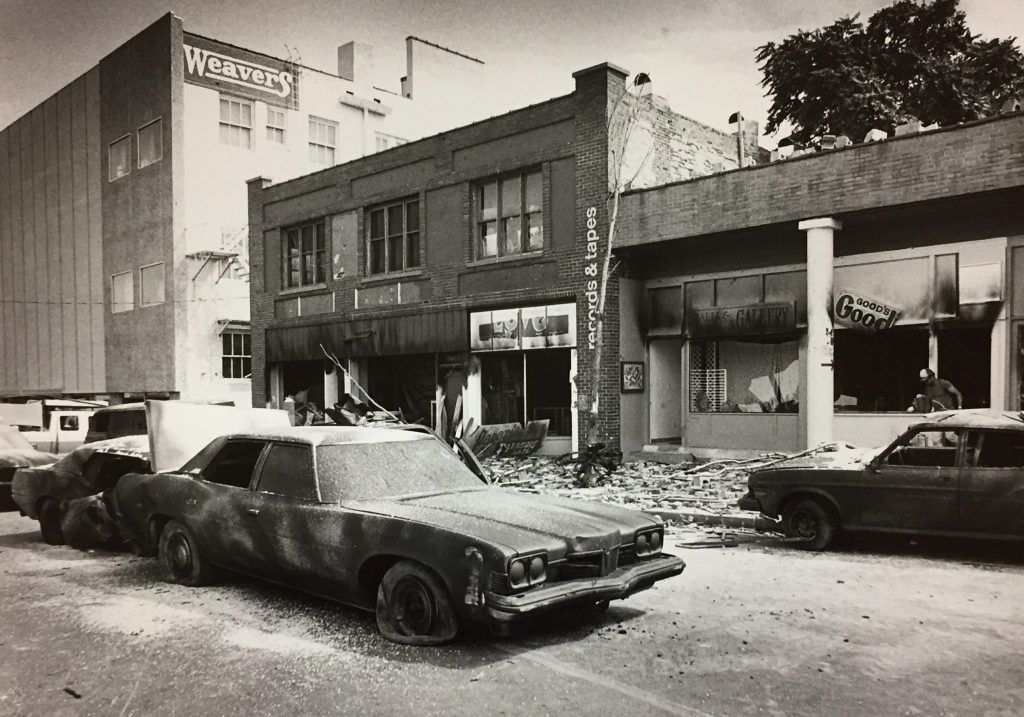

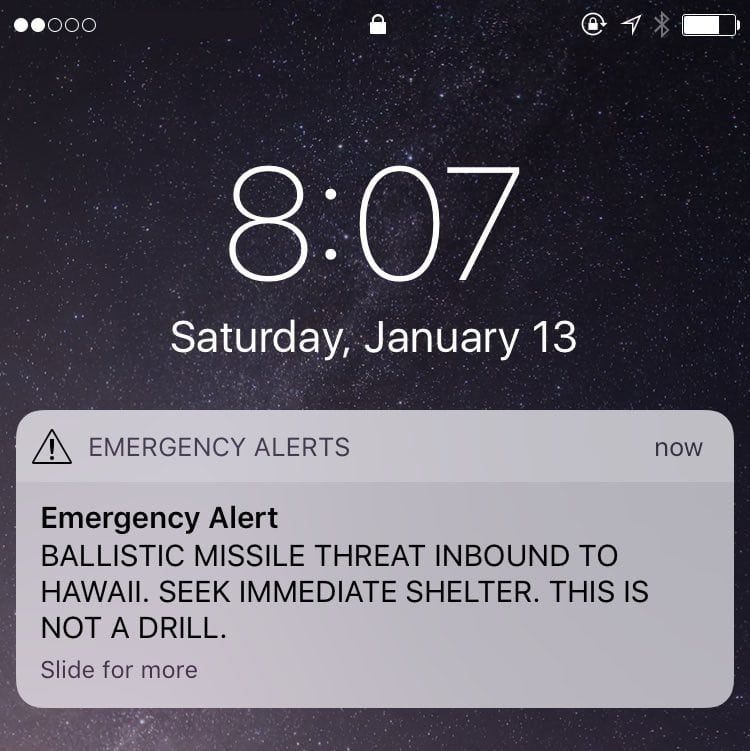

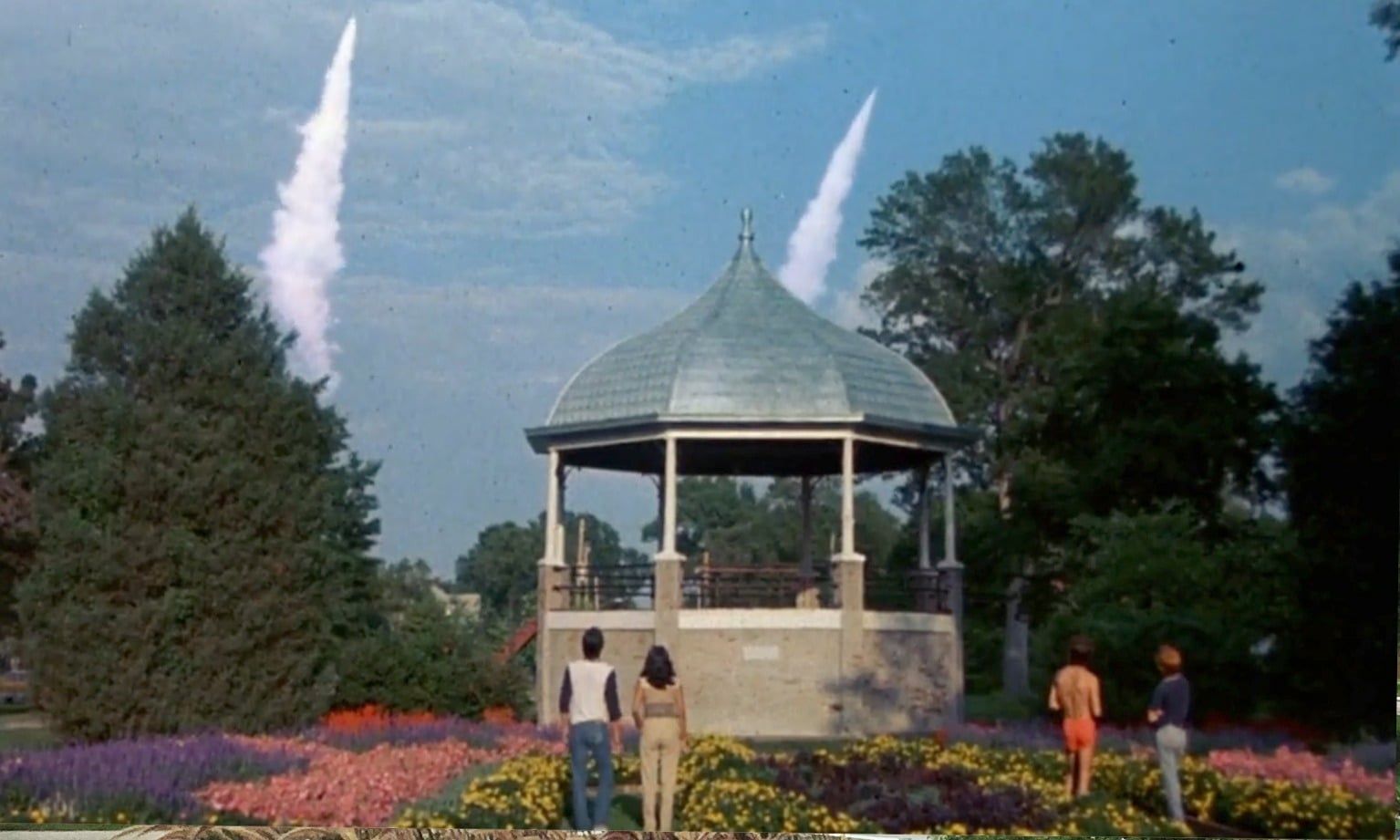

PLEASE WATCH THIS MOVIE, EVEN IF YOU SAW IT BACK IN 1983. IT IS ALSO IMPORTANT THAT OUR YOUNGER GENERATIONS WATCH AND UNDERSTAND EXACTLY WHAT NUCLEAR WAR MEANS, ESPECIALLY WHEN IT COMES TO OUR NEIGHBORHOOD. THIS WAS A MADE FOR TV MOVIE, BUT IT WAS STILL VERY HARD TO WATCH AT TIMES, EVEN THOUGH THE HORROR OF NUCLEAR DETONATIONS HAD TO BE SCALED BACK. WHEN WATCHING THE MOVIE, MULTIPLY WHAT YOU SEE BY 10 TIMES AND THAT STILL WON’T BE ENOUGH TO COMPREHEND JUST HOW DEVASTATING A NUCLEAR ATTACK CAN BE.
Agree that this is a very important and timely reminder of the continuing menace that exists in our world from these ecocidal weapons. I am concerned that we have not yet learned the lessons of the 80’s that although we can raise awareness, scare the hell out of people, and make some progress toward the elimination of nuclear weapons… we didn’t succeed. It is not enough to scare people. The continued presentation of end of the world horror also makes people despair. If there is no hope in the inevitable progress of humanity’s race toward oblivion, why care about anything?… Read more »
I WANT TO KNOW SPECIFIC, CONCRETE ACTIONS THAT I, AGE 86 BUT WITH EIGHT HEALTHY AND ALERT GRANDDAUGHTERS, CAN TAKE TO DIMINISH THE DANGER OF THE END OF CIVILIZATION.
Perhaps join like-minded individuals, organizations, and institutions by educating yourself, your granddaughters, and others about the reality of the common global threats that may end life (in all its myriad forms) on our planet including, but not limited to: “mutually assured destruction” by nuclear means (manmade), and disastrous global/cosmic events (natural). Then seek and share andy wisdom, knowledge, and understanding about historically effective responses, global conflict resolution; non-violent ways; means of affecting positive culural societal change. Finally, take action to implement or progressively redevelop those ways toward minimizing those dangers. Hope this is helpful, Allen. Happy Holidays to you and… Read more »
@chris d green’s answer has really captures it. I’d reinforce knowing the facts and standing for them. Pushing back against “alternative facts” is key to the kind of global consensus we’ll need. The only other thing I’d add is that you, taking a visible stand and conveying it to your granddaughters is a gift in itself. That realization is powerful: the choice is really “who will I be to my grandchildren when the effects of climate change and god forbid some of these other threats take shape? Will they remember me as someone who stood aside or as someone who… Read more »
Vote for Democrats.
“…there is no hope in the inevitable progress of humanity’s race toward oblivion, why care about anything?”
I concur. As long as nuclear weapons exist, their use is inevitable, either deliberately or accidentally.
If you, or anyone else thinks there’s a possibility of eliminating nuclear weapons from this planet, I’m sorry, but you’re just wishfully thinking.
“Hope for what?” the pregnant woman asks the doctor in the scene from The Day After “We knew the score. We knew all about bombs. We knew all about fallout. We knew this could happen for 40 years. Nobody was interested.” We do know all the arguments: yet here we are again facing the threat of nuclear war. The problem is that our only experience comes from the Cold War. But the Cold War was the peace. The world has experienced periods of peace (or relative peace) throughout history. The Thirty Years Peace between the two Peloponnesian Wars, Pax Romana,… Read more »
The Day After seemed like nuclear war lite…
For a taste of what nuclear war would really be like in one of our major cities, watch Peter Watkins’ film THE WAR GAME – commissioned by the BBC in 1965, and banned by them for many years thereafter.
It’s hard to believe a piece this long about The Day After doesn’t mention War Game, since it’s pretty directly based on it.
“Testament” is also more like the reality of nuclear war, but the REAL reality is that in an all-out nuclear exchange, all life on this planet will end…quickly.
Two more films of the same ilk worth mentioning — Threads and When the Wind Blows. Both brutal in their own way.
And, as noted by, I believe, William F. Buckley at the time, not one bit of the destruction in the movie was caused by an American nuclear weapon.
The movie was obviously part of the attempt to orchestrate panic by the nuclear freeze campaign.
I remember this panel. Serious men talking about a serious topic. Except of course for Buckley who saw it as an opportunity to inject his usual brand of tedious faux intellectual buffoonery into serious discourse.
Quite a poignant film and it should be redone today. I highly doubt most Americans younger than 40 even recognize the terrible consequences of a nuclear war. The aftermath is SO awful the U.S. government has given up the idea of any “Civil Defense” like they did in the 60s. I lived through the Cuban missile crisis and remember the Conelrad alerts on Radio (little carets on the dial at 640 and 1240) and the “duck and cover” exercises at elementary school. In truth it would be much MUCH worse than depicted in “The Day After”. Because there really wouldn’t… Read more »
I’m 73.
“Duck and Cover”?
The wooden desks were kindling.
I would like to congratulate Dawn Stover for this excellent, authentic walk back through modern history. I teach a course on activism during the Cold War at a tier 1 university and the Day After is always a feature of the course, representing the zeitgeist of the times in many ways. Students are left in stunned silence no matter where I stop the movie–the threatening buildup to the attack, the nuclear storm itself, or somewhere during the aftermath. There are no safe places in this movie to catch your breath. Nicholas Meyer and colleagues produced a masterpiece of living history… Read more »
I’m 73 years old, and ever since the days of Bert the Turtle and “Duck and Cover” we’ve all lived in fear of WWIII. And now, with so very many nuclear-armed countries, it’s inevitable, caused either deliberately or accidentally, it matters not. As demented as it may sound, I truly wish it’d just happen and get it over with. The suspense is excruciating. When I think of the trillions of generations that have lived on this planet, I feel it would be a privilege to be among the relative few to be here when it ends, and I’ll be greatly… Read more »
The TV landscape is so fragmented today. Is it even possible for a TV movie like this to have the same impact socially and politically? I’m glad THE DAY AFTER took advantage of its moment to garner over 100 million viewers in the US alone, an impossible feat today. I’m in production with a feature documentary on this very subject and am happy to hear from anyone who can share stories or archive material relating to THE DAY AFTER’s production.
I was born two months before the Trinity test, grew up 19 miles from Los Alamos, and have been involved in analyzing the history of nuclear weapons laboratories for most of the past half-century. I find little hope that an amorphous group of citizens whose ambiguity about basic democratic values divides them into tribal camps can counter the efforts of those who have found nuclear weapons so “technically sweet” that they can’t stop making them, or those of Russian spies who have transferred nuclear weapons technology to their allies around the world. Although a film which replicated, on a much… Read more »
Well done. I sent this to everyone I know. People, there is never a bad time to discuss this issue, and you’ll never be thanked for it, either. Oh, well; if people say “this is not the time,” ask, “OK, when, then?” That usually helps drive the point home. 🙂
I remember The Day After as seeming quite trivial in its depiction of the aftermath of nuclear war, relative to the likely truth of the matter. If I recall correctly, the broadcast was immediately followed by Threads, a much more realistic depiction. Threads is available on YouTube. Highly recommended.
Threads is a British TV film that aired about 10 months after The Day After. Its first US broadcast was in early 1985. It is available on DVD and Blu-ray.
The article is fine BUT the snarky comments about Trump at the end remind me of those about Reagan up to the time of the Gorbachev-Reagan accords. (LBJ watched TV all the time, for example – AND the charge against Trump on this score is gossip. The Bulletin can do better than report gossip.). Trump has shown himself to be capable in Korea where we now have abandoned our “provocative” (Trump’s phrase) war games while the DPRK has abandoned testing of nuclear weapons and ICBMs, things that are often dismissed as no progress in the mainstream media. Trump has also… Read more »
“…while the DPRK has abandoned testing of nuclear weapons and ICBMs…”
They need no further testing. They have nuclear weapons and a means of delivery, and they no doubt have an EMP device and the capability to deplioy it.
“Blah blah blah the representatives of the Deep State…”?
“Deep State”? Aren’t they also responsible for chemtrails?
Tighten the chin-strap on your foil hat.
[…] I am 9 and my brother is 8. Our sister has just turned 2. As a general rule, we are not permitted to watch television, except for the nightly news. But on this random Sunday before Thanksgiving, we Berrigan children get a special treat. We watch a television movie with our parents. It is called “The Day After.” […]
With knowledge of the horrific suffering and inevitable death caused by the exposure to the effects of the radioactivity that will be released by a thermonuclear war, upon seeing the mushroom cloud of a nuclear weapon, I suggest you do what I’m going to do: Run!… TOWARD IT!
Thanks for discussing your ideas. I would also like to state that video games have been actually evolving. Modern tools and inventions have made it simpler to create practical and fun games. These types of entertainment video games were not that sensible when the actual concept was first being used. Just like other areas of technologies, video games also have had to advance through many ages. This is testimony to the fast progression of video games.